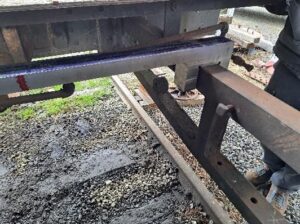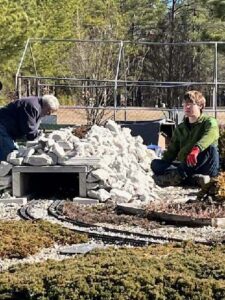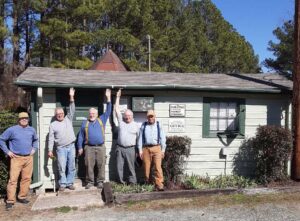Volume 64 – Issue 3 1 March 2024
From the Brass Hat
Spring is almost here! February was a much calmer month around the Museum, but many things were getting done. Plenty of planning and administrative work has continued. The Board of Directors voted to deaccession two excess 85-pound track switches for potential sale to another organization. The Board also voted to deaccession the Harsco Mark IV production tamper and to investigate its’ potential sale as well. Sale of this machine could be a huge addition to our financial stability.
As you will see in this issue, we have a new tunnel on our railroad (the G Scale side) and a new roof on the Yard Office. That little building has a lot of history behind it as the only building standing when we took possession of the property in 1983. All our other buildings came from other locations, some in one piece, some disassembled, moved and reassembled on our property. Perhaps we could get some articles written about the origins of our buildings (like we did for the Goldston Depot)?
Projects around the yard include general grounds improvements in preparation for our anniversary activities, several weekends of work toward a truck-swap for caboose 308 (putting in standard freight car trucks so we can get the historically-correct leaf-spring trucks refurbished next year), and a visit by Steam Operations Corporation experts to continue the repairs to our beloved Steam Locomotive 17. We still have some major steps to complete before we can begin reassembly by our volunteers, but we are inching our way toward that goal and the eventual return of steam to the NHV. Another thing to celebrate when the time comes!
Start gathering your 1900 era costume for the April 20-21 Anniversary celebrations. Nothing in particular required, as long as it looks “right” for the period. Jim Whitten can offer additional advice. John Morck needs a top hat that weekend!
As Always, Thanks for all you do for our Museum.
Respectfully submitted,
Chris Tilley
President, NCRM
Get to Know a Member
by Tom Hutchinson
Name: Bob “Doc” Majors
How long have you been a member? Since 1973
Where are you originally from? I was born and raised in Charlotte, a small, struggling community, also known as the Capital of the State of Mecklenburg.
What is/are/were your job(s) in real life? I was a physician, practicing otorhinolaryngology – head and neck surgery, in Raleigh for 40 years. This was after I had left my former employer which operated a large fleet of big gray boats and had an associated group that had a song about the “Halls of Montezuma”.
Where do you live now? Raleigh, NC
How did you become interested in trains? When I was a kid, Charlotte was the eastern terminus of the Piedmont and Northern Railway, but also had trackage from the Southern Railway, Norfolk Southern, and Seaboard rail line. My interest in railroads came from exposure to all of the above. I spent many hours at the SR depot on West Trade street in Charlotte in the waning days of steam, wandering among the office cars at a time when almost every official had one. A Cub Scout trip to Spencer, then an active steam shop, was a memorable experience.
What is your favorite activity at the New Hope Valley Railway? Shifting cars with the John Deere tractor and hand braking same was a great event. I’ve had a part in restoring/painting/lettering some cars at Bonsal, and that remains a main interest. I still have the paintbrush that Robert Middour bought for me when I started on the Beaufort and Morehead project, and am using it again on the ACL baggage car project. It’s my fond hope it will last.
If you do not receive the operating crew calls, please contact the crew caller if you are interested in participating in train operations!
Anniversary History: Merger of the New Hope Valley Railroad with the Durham & South Carolina Railroad
by Victor Varney
This is a follow up article to last month’s article about the formation of the New Hope Valley Railroad in 1904.
After the NHVRR was formed, land was acquired to build the line from Bonsal up to West End (now called Carrboro). Subsequently, the NHVRR investors decided that merging with another group of investors and extending the line north to Durham, and south from Bonsal would be a more attractive business. On April 1, 1905 the NHVRR investors met in Pittsboro and agreed to merge the assets of their line into the D&SC which itself was formed on January 20. 1905.
For doing so, the D&SC RR paid $27,691.36 to shareholders for all stock, assets, easements and franchises of the NHVRR. This transaction was subsequently adopted at a meeting with the D&SC RR on April 7, 1905 at Hamlet, NC. W.R. Bonsal as then President of the NHVRR signed this agreement. The final page shows the notarization of this agreement in Richmond county that same day, and at the bottom a subsequent notarization in Chatham county on April 14.
Page 1 is actually the cover for this folded agreement showing how the deeds to the property were subsequently conveyed to the D&SC RR and recorded in Chatham and Wake counties on April 14 and 20, respectively. And with that the New Hope Valley Railroad came to exist no more.
Thanks to Tim Carroll for rescuing this 1905 document that he found in an antique store in NC.
Next month look for an article marking our 40th anniversary running trains for visitors.
New Member Orientation
by Victor Varney
The next new member orientation session will be offered on Saturday March 30 from 10 am to noon. It will be held under the covered area behind the yard office, and include a tour of the property along with some of our ongoing projects. The new member orientation session is intended to share information about our history, bylaws, how to get information, who’s who, and most importantly how to get involved as a volunteer (and have fun). This session is open to those who have been members for up to 2 years. This is not a substitute for the rules and safety training sessions necessary to get involved with train operations, but we will explain how to attend those sessions, too. This will be the first of two orientation sessions offered in 2024. The next one will be on Saturday September 14. If you are interested in attending on March 30, please RSVP to Victor Varney by Wednesday March 28.
[Editor’s note: If you have photos or other info about long-ago (or recent) events at the NCRM, please contact your editor. You can submit your own “Back in the Old Days…” or other article with pictures about anything (within reason) from our past for the Telegrapher. If you can rough out the ideas, we can work with you to craft an article to benefit the entire membership. – CT]
The Garden Railroad Crew are pictured building a new storage tunnel which will be buried within a mountain. THAT is a stout model railroad tunnel! Tom Hutchinson photos. The Dispatcher’s Office has received a new roof thanks to the Wednesday Crew!
The Dispatcher’s Office has received a new roof thanks to the Wednesday Crew!
Where there is smoke, there is fire!
This photo, captured from a larger video file shows our orange ballast tamper firing up after years of inactivity. A small, dedicated group from the Wednesday crew has been working to get this valuable machine running again. A myriad of hydraulic lines still need to be tested before our track crew can put it back into action. This will be one of the biggest labor-saving tools in our inventory.  Anyone who has tamped ballast under rail ties with nothing but a bar can appreciate the magnitude of this dramatic event! MAJOR kudos to all involved in this project.
Anyone who has tamped ballast under rail ties with nothing but a bar can appreciate the magnitude of this dramatic event! MAJOR kudos to all involved in this project.
Steam News
by Luke Sullivan & Mike MacLean
The springs from Locomotive 17 have been removed for inspection and needed repairs by Steam Operations Corp. The springs help the locomotive ride “smoothly” and keep all wheels fully in contact with the rails regardless of minor track fluctuations for maximum tractive power. The final machining of the new replacement furnace bearers is also ongoing. These attach the firebox end of the boiler to the frame while allowing a small amount of front-to-rear movement to account for heat expansion and contraction of the boiler during operations.
Moving Steel
As part of the general cleanup of the grounds, our members are moving the heavy steel workbench and heavyweight project materials from in front of the tool container. One might be amazed at the variety of things built or repaired on that workbench over the years. Your editor once saw a flying steel pig sitting on it – no idea where it came from, where it went or why it was there… If that table could talk!







